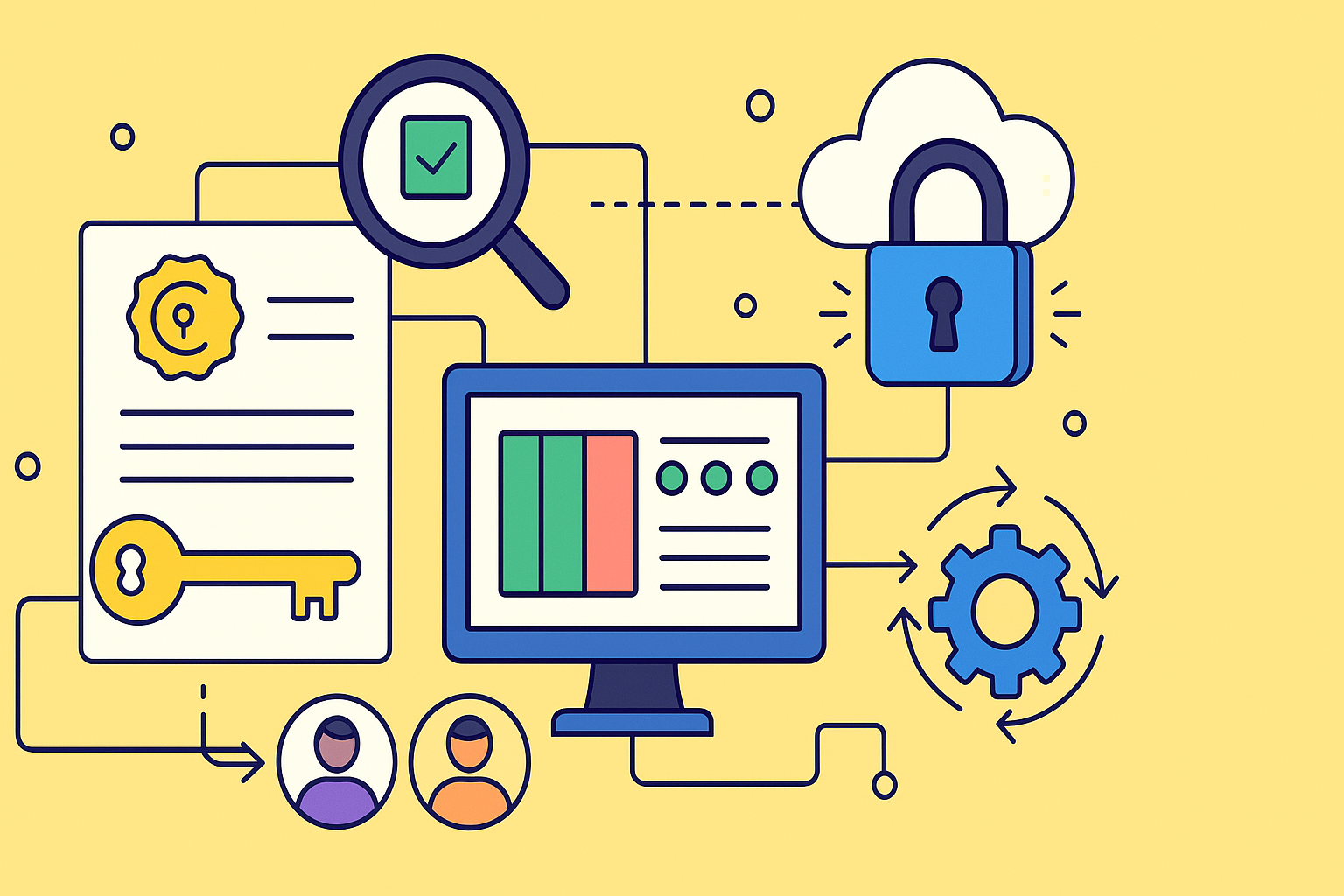In today’s complex IT landscape, managing software licenses has evolved from a simple administrative task into a critical strategic function. With the rise of SaaS, hybrid environments, and increasingly aggressive vendor audits, organizations face mounting pressure to control costs, ensure compliance, and maximize the value of their software investments. Ineffective management leads not only to significant financial waste but also to severe compliance risks and security vulnerabilities.
This article cuts through the noise to provide a definitive guide on software license management best practices. We will explore seven actionable strategies that go beyond the basics, offering a detailed roadmap for transforming your software asset management (SAM) from a reactive burden into a proactive, value-driven powerhouse.
You will learn how to implement a robust framework for everything from initial asset discovery to strategic vendor negotiations. Special attention is given to optimizing licenses within dynamic ecosystems like Atlassian, where fluctuating user counts directly impact costs and operational performance. The following best practices will help you:
- Establish a comprehensive software inventory to gain full visibility into your assets.
- Centralize license tracking to eliminate silos and improve control.
- Maintain continuous compliance to avoid costly penalties during audits.
- Optimize license usage by reclaiming unused seats and right-sizing subscriptions.
- Automate provisioning workflows to enhance efficiency and reduce manual error.
Get ready to implement proven methods that will secure your digital assets, slash unnecessary spending, and empower your teams to work more efficiently.
1. Comprehensive Software Asset Discovery and Inventory Management
The foundational step for any effective software license management strategy is knowing precisely what you have. Comprehensive software asset discovery is a systematic approach to identifying, cataloging, and maintaining a real-time, accurate inventory of all software assets across your entire organization. This goes far beyond just installed applications on desktops and laptops; it must encompass cloud-based services, SaaS subscriptions like your Atlassian suite, and virtual instances that can easily be overlooked.
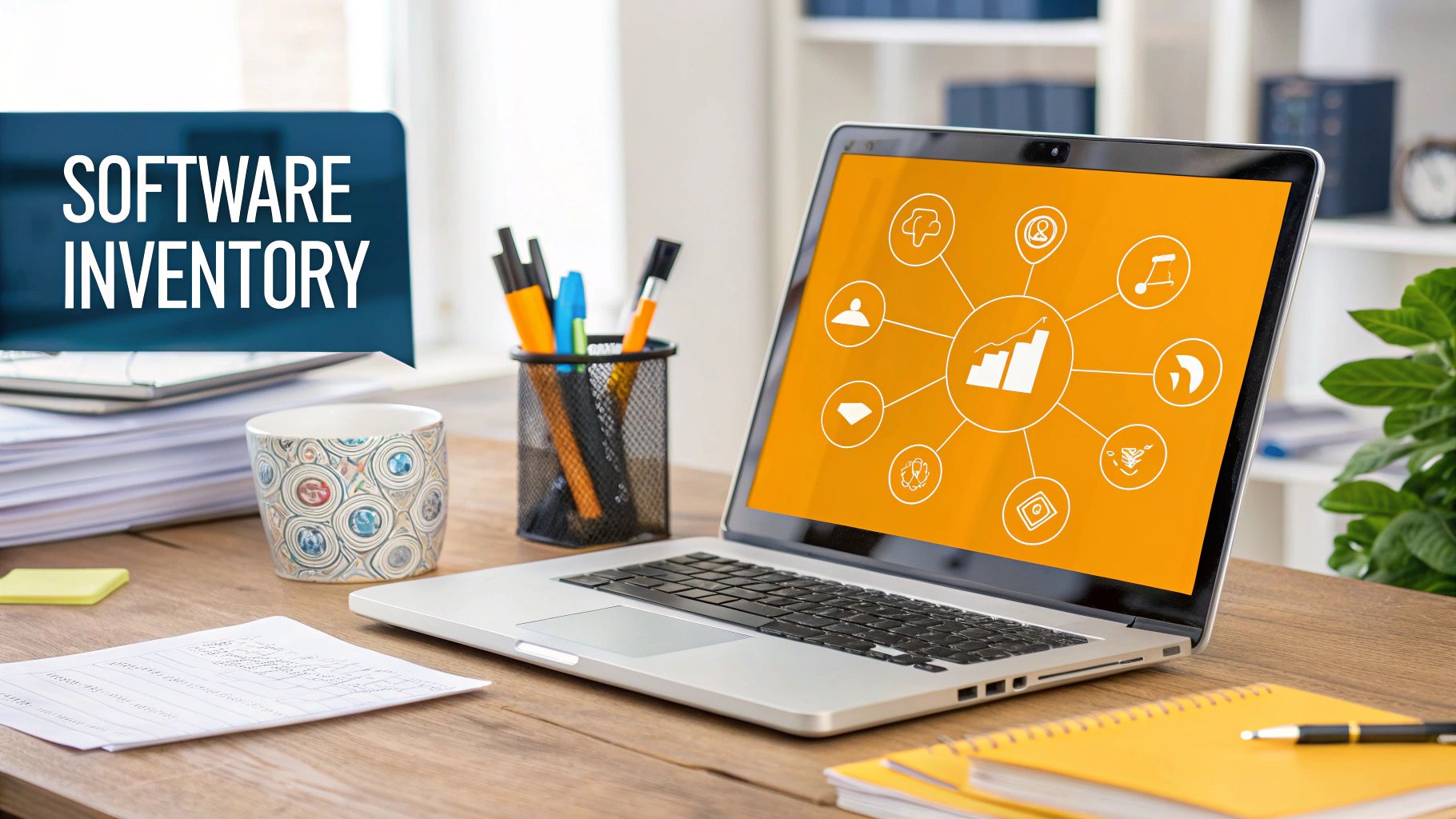
Creating this single source of truth is the difference between navigating with a precise map versus stumbling in the dark. It is essential for eliminating shadow IT, making informed optimization decisions, and establishing a firm baseline for compliance audits. An accurate inventory provides the data-driven clarity needed to move from guessing to knowing, transforming how you manage and secure your software landscape.
Why This Practice is Foundational
Without a complete inventory, any subsequent software license management best practices will be built on a shaky foundation. You cannot optimize what you cannot see, and you cannot secure what you do not know exists. This initial step directly impacts budgeting, security, and operational efficiency. For instance, large enterprises like Microsoft have successfully deployed tools such as System Center Configuration Manager across hundreds of thousands of endpoints to achieve this level of visibility. Similarly, major financial institutions rely on platforms like Lansweeper for comprehensive IT asset discovery to meet strict regulatory requirements.
Key Insight: An accurate, real-time inventory is not a one-time project; it is a continuous process that forms the backbone of proactive license management and cybersecurity defense. It prevents overspending on unused licenses and mitigates the risk of non-compliance penalties.
Actionable Implementation Steps
To establish a robust discovery and inventory system, follow these practical steps:
- Automate First, Validate Manually: Deploy automated discovery tools like ServiceNow Discovery, Flexera One, or Lansweeper to scan your network, cloud environments, and endpoints. However, always supplement this with manual validation to catch exceptions and confirm the accuracy of the automated data.
- Schedule Regular Scans: Your IT environment is dynamic. Set up automated scans on a regular schedule (e.g., daily or weekly) to capture new software installations, updates, and removals to keep your inventory current.
- Standardize Naming Conventions: Create and enforce standardized naming conventions for software titles, versions, and publishers. This prevents duplicate entries and ensures consistent, reliable reporting.
- Integrate with Your ITSM: Connect your discovery tools with your IT Service Management (ITSM) platform, such as Jira Service Management. This integration creates a cohesive ecosystem where asset data informs service requests, incident management, and change control processes. For a deeper understanding of this topic, you can explore more about data integration best practices.
2. Centralized License Management Platform Implementation
After establishing what software exists, the next critical step is to consolidate how you manage it. Implementing a centralized license management platform creates a unified system that aggregates all software license information, contracts, entitlements, and compliance data. This single source of truth allows organizations to manage licenses across numerous vendors, track complex usage patterns, and automate compliance reporting from one dashboard, moving beyond disconnected spreadsheets and siloed vendor portals.
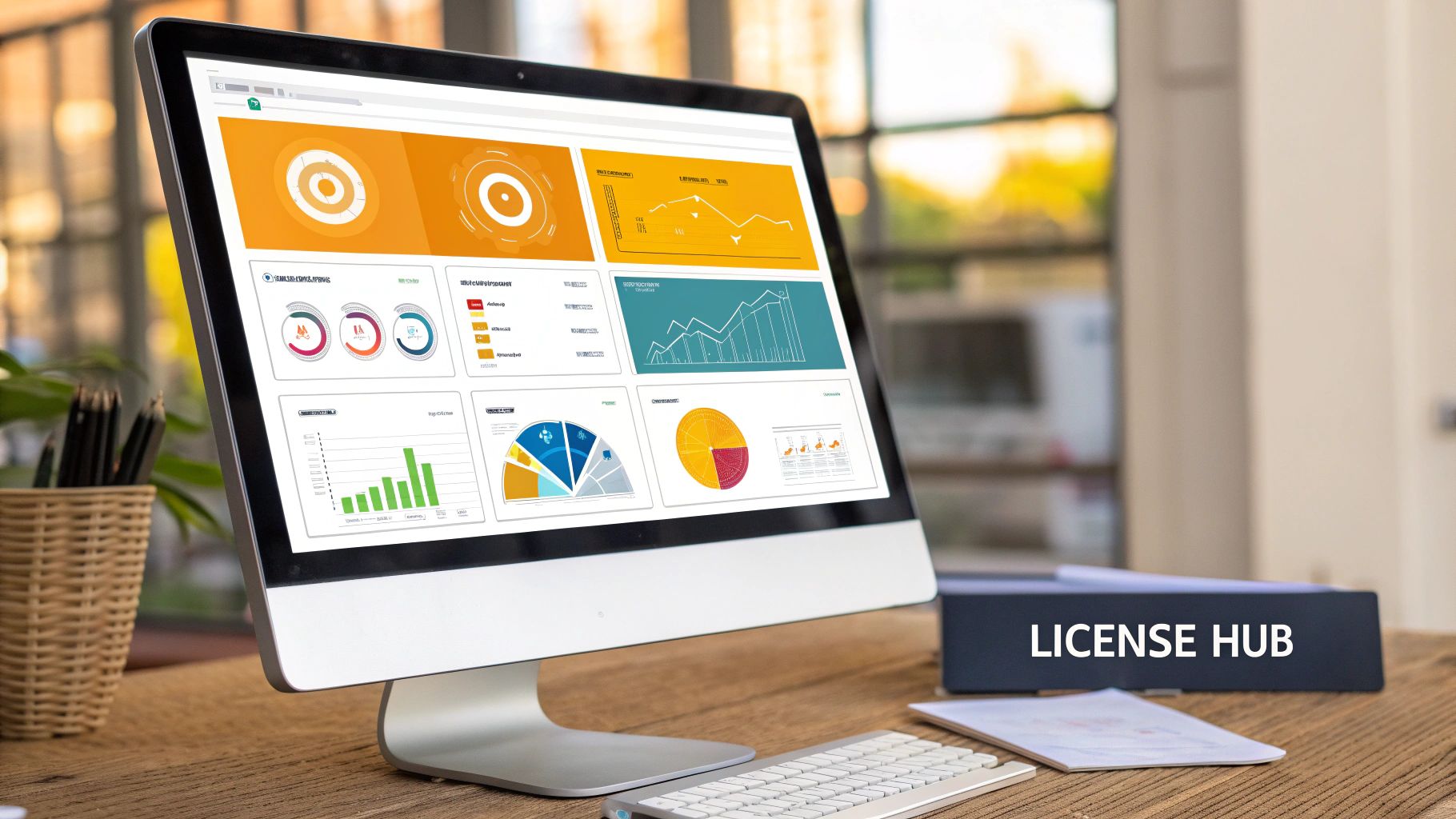
This approach transforms license management from a reactive, chaotic scramble into a strategic, proactive discipline. Instead of hunting through emails for renewal dates or manually reconciling invoices, a centralized platform provides immediate, actionable insights. It empowers you to optimize costs, ensure continuous compliance, and align software spending with actual business needs, a core component of effective software license management best practices.
Why This Practice is Foundational
A centralized platform bridges the gap between your software inventory and your procurement records. Without it, you are left with disparate data sets that are nearly impossible to reconcile, leading to over-provisioning, compliance gaps, and missed optimization opportunities. Large enterprises use platforms like ServiceNow Software Asset Management to manage thousands of contracts and software titles, while government agencies often rely on Flexera One to maintain strict compliance and audit readiness. Even vendor-specific tools like Adobe’s Admin Console or Microsoft’s Volume Licensing Service Center (VLSC) embody this principle on a smaller scale, centralizing control for their respective product suites.
Key Insight: Centralization is not just about convenience; it is about control and visibility. A dedicated platform turns raw inventory data into financial and compliance intelligence, enabling strategic decision-making rather than administrative firefighting.
Actionable Implementation Steps
To successfully deploy a centralized management system, focus on these practical steps:
- Choose an Integration-Friendly Platform: Select a platform from leaders like ServiceNow, Flexera, or Snow Software that integrates seamlessly with your existing IT infrastructure, including your ITSM, discovery tools, and procurement systems. This ensures data flows automatically, reducing manual entry and errors.
- Establish Clear Data Governance: Before implementation, define who is responsible for entering and maintaining data, what information is required for each asset, and how data quality will be enforced. Strong governance prevents the platform from becoming another unreliable data silo.
- Start with a Pilot Program: Roll out the platform to a single department or for a specific high-value vendor first. This pilot phase allows you to refine processes, gather user feedback, and demonstrate value before a full-scale enterprise deployment.
- Handle Hybrid Environments: Ensure your chosen platform can effectively manage licenses for both traditional on-premises software and modern cloud-based or SaaS subscriptions. This flexibility is crucial for today’s hybrid IT landscapes.
3. Proactive License Compliance Monitoring and Audit Preparation
Beyond simply knowing what you have, effective software license management best practices demand a continuous process of monitoring usage against entitlements. Proactive license compliance monitoring is the practice of regularly assessing your software deployments against your purchased licenses to identify and remediate potential compliance gaps before they escalate into costly problems. This involves maintaining audit-ready documentation and being perpetually prepared for a vendor audit.
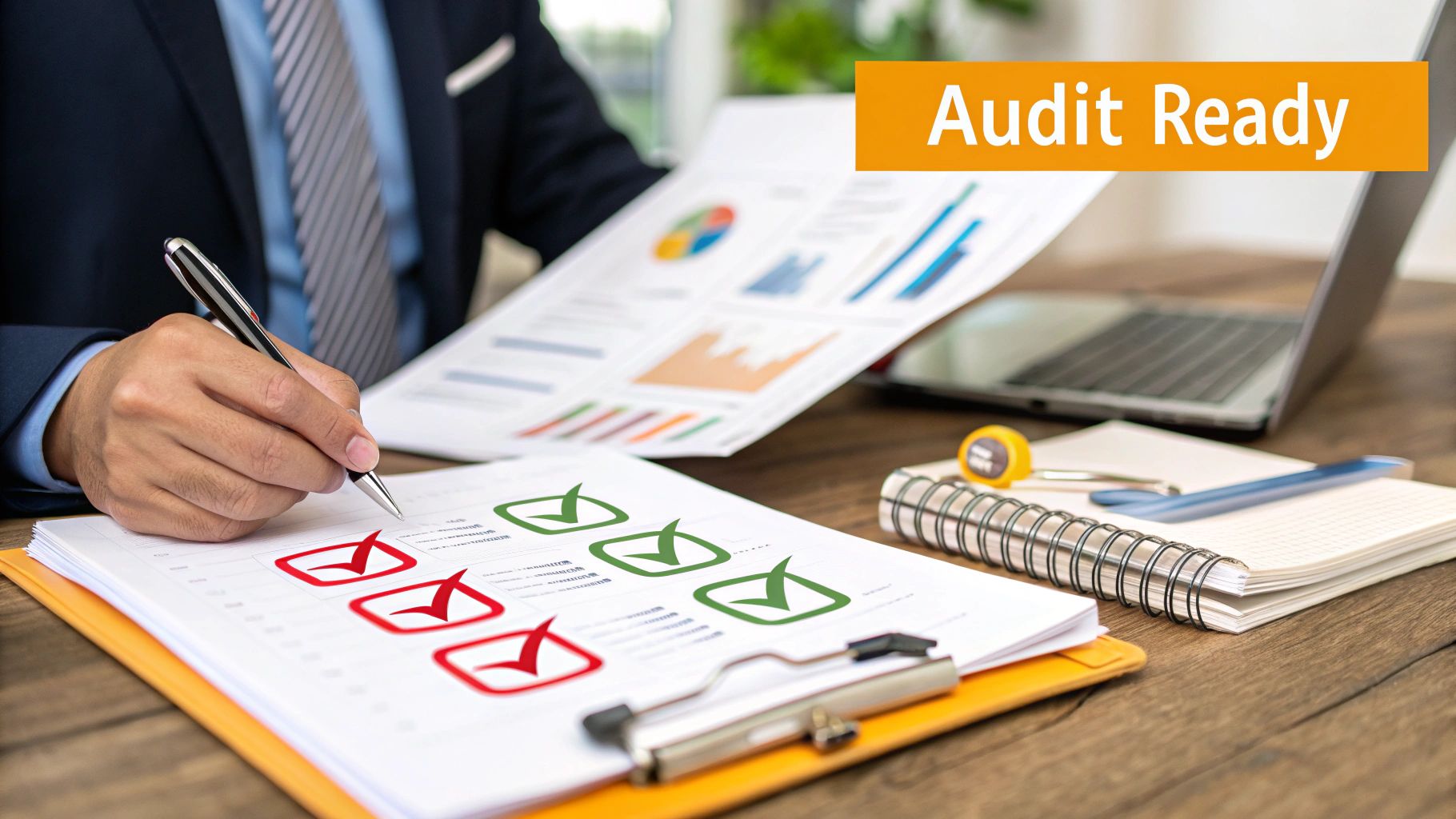
This approach shifts your organization from a reactive, crisis-driven state during an audit to a controlled, proactive posture. By constantly verifying your compliance position for key vendors like Oracle, Microsoft, or even Atlassian, you minimize financial risk and operational disruption. It transforms the dreaded audit from a potential disaster into a routine validation of your well-managed IT environment.
Why This Practice is Foundational
Failing to monitor compliance is like driving without checking your speed; you may be fine for a while, but eventually, you will face a significant penalty. Software vendors generate substantial revenue from non-compliance penalties, and audits are a primary tool for revenue assurance. Major consulting firms like Deloitte and KPMG have built entire advisory services around helping organizations navigate these complex audits. For example, large financial institutions implement continuous SAP compliance monitoring to avoid seven-figure true-up costs, while healthcare organizations systematically prepare for Adobe Creative Suite audits to ensure they meet strict usage terms.
Key Insight: The goal of proactive compliance monitoring is not just to pass an audit, but to make the audit a non-event. Maintaining a constant state of audit readiness eliminates fire drills, reduces legal exposure, and strengthens your negotiation position with software vendors.
Actionable Implementation Steps
To build a robust compliance monitoring and audit preparation program, follow these steps:
- Establish Regular Compliance Reviews: Institute a formal schedule for compliance assessments, such as monthly or quarterly. Dedicate this time to reconciling deployment data from your inventory system with your entitlement records for high-risk or high-spend vendors.
- Create Vendor-Specific Audit Playbooks: Different vendors have unique and often complex licensing rules. Develop vendor-specific checklists and procedures that detail license metrics (e.g., per user, per core, per instance), deployment rules, and required documentation for vendors like Oracle, Microsoft, and SAP.
- Maintain an Audit-Ready Evidence Repository: Centralize all relevant documentation, including purchase orders, contracts, license agreements, proof of entitlement, and records of software removals. This repository should be your single source of truth when a vendor requests information.
- Conduct Mock Audits: Simulate a vendor audit internally to test your processes, data accuracy, and team responsiveness. This practice, often guided by partners like PwC or Ernst & Young, identifies weaknesses in your defense strategy and prepares your team for the pressure of a real audit.
4. Strategic License Optimization and Right-sizing
Once you have a comprehensive inventory, the next logical step in effective software license management best practices is to ensure you are not just counting assets, but truly optimizing them. Strategic license optimization is the systematic process of analyzing software usage data against business requirements to align license quantities, types, and costs with actual need. This involves actively identifying underutilized licenses, reallocating them where needed, and choosing the most cost-effective licensing models available.
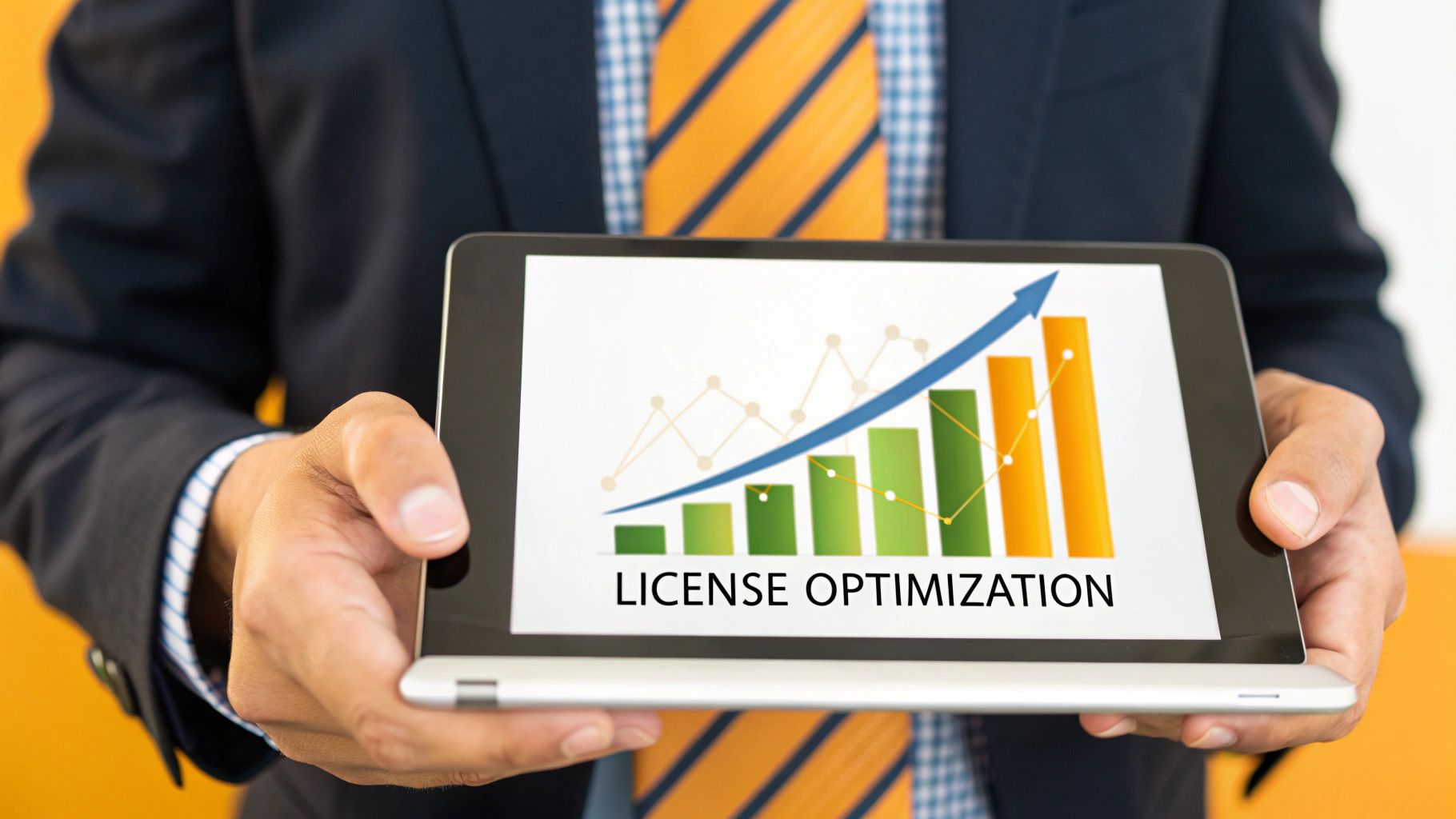
This practice moves beyond passive inventory management into active, value-driven decision-making. By right-sizing your software portfolio, you can eliminate significant waste, redirect budget to higher-priority initiatives, and maintain compliance without overspending. It is about paying for what you use, and only what you use, transforming your software licenses from a fixed cost center into a flexible, optimized asset.
Why This Practice is Foundational
Failing to optimize licenses is like leaving money on the table. In complex environments, it is common for 20-30% of software licenses to be underutilized or completely unused. This waste accumulates rapidly, especially with high-cost enterprise software. For example, IBM famously saved over $50 million annually by implementing its own internal software asset management and optimization programs. Similarly, many large consulting firms use data-driven analysis to right-size their Microsoft Office 365 subscriptions, moving users between E3 and E5 licenses based on their actual usage of advanced features. This proactive management is critical for fiscal health and operational agility.
Key Insight: License optimization is not about cutting essential tools; it is about eliminating waste through data-driven precision. The goal is to ensure every dollar spent on software delivers maximum value by matching the license type and quantity to real-world user activity.
Actionable Implementation Steps
To implement a strategic optimization and right-sizing program, follow these practical steps:
- Prioritize High-Value Licenses: Start your optimization efforts where they will have the biggest impact. Focus on high-volume, high-cost software such as Oracle databases, SAP systems, or enterprise-wide SaaS platforms like Jira Data Center or Cloud Enterprise.
- Leverage Usage Metering: Deploy tools that can track application usage, feature adoption, and login frequency. This objective data is far more reliable than relying on user surveys or assumptions to determine if a license is truly needed.
- Implement License Harvesting: Create a process for automatically reclaiming and reallocating inactive licenses. If a user has not logged into a specific application for a set period (e.g., 90 days), their license can be temporarily revoked and placed back into a pool for new requests.
- Review License Metrics Regularly: Software vendors offer various license models (per-user, per-device, concurrent, processor-based). Regularly review your contracts and usage patterns to ensure you are on the most cost-effective metric for your organization’s needs. For specific guidance on Atlassian products, explore this detailed Jira license cost optimization framework.
5. Automated License Provisioning and Workflow Management
Manually handling license requests, approvals, and assignments is a time-consuming, error-prone process that creates bottlenecks and frustrates users. Automated license provisioning and workflow management replaces this manual toil with a streamlined, efficient system. This practice involves using technology to manage the entire license lifecycle, from a user’s initial request through approval, provisioning, and eventual deprovisioning when they leave the organization or change roles.
Implementing self-service portals and automated workflows is the difference between a reactive, ticket-based system and a proactive, service-oriented one. It empowers users, frees up IT staff for more strategic tasks, and ensures that license allocation is both swift and compliant with internal policies. This level of automation is critical for maintaining control and visibility as organizations scale their software usage.
Why This Practice is Foundational
Without automation, license management becomes a significant operational drag, delaying projects and leading to poor user experiences. Automating these workflows directly enhances productivity, strengthens governance, and optimizes costs. For example, large tech companies rely on platforms like Okta to automate SaaS license management, tying access directly to user roles and group memberships. Similarly, government agencies have successfully implemented automated Adobe license provisioning to ensure only authorized personnel receive access, drastically reducing compliance risks and manual overhead.
Key Insight: Automation transforms license management from a purely administrative function into a strategic enabler. It ensures that the right people get the right software at the right time, while providing an auditable trail for every license assigned and revoked.
Actionable Implementation Steps
To build a robust automated provisioning and workflow system, follow these practical steps:
- Start with High-Volume Licenses: Begin your automation journey by targeting high-volume, standardized software requests, such as licenses for your Atlassian tools like Jira or Confluence. This approach delivers immediate impact and allows your team to refine the process before tackling more complex software.
- Establish Clear Approval Workflows: Define and configure clear approval criteria, multi-step chains, and escalation paths within your system. For instance, a request for an expensive engineering application might require both a manager’s and a department head’s approval. You can learn more about how to automate approval workflows with Jira.
- Integrate with HR and Identity Systems: Connect your workflow tool with your HR Information System (HRIS) like Workday and your Identity and Access Management (IAM) solution like Okta or Azure AD. This integration enables true zero-touch onboarding and offboarding, automatically provisioning licenses for new hires and revoking them upon termination.
- Implement Budget Controls and Limits: Configure the system with built-in budget controls. Set approval limits for managers and create alerts that notify stakeholders when a department is approaching its software budget, preventing uncontrolled spending.
6. Vendor Relationship Management and Contract Optimization
Effective software license management extends beyond tracking assets; it involves strategically managing the relationships with the vendors who supply them. Vendor relationship management and contract optimization is a proactive approach focused on building strong partnerships, negotiating favorable terms, and continuously refining agreements to maximize value and minimize costs. This practice transforms procurement from a transactional function into a strategic advantage.
By treating vendors as partners, organizations can gain access to better pricing, superior support, and early insights into product roadmaps. This collaborative approach is critical for navigating complex licensing models, such as Microsoft Enterprise Agreements or Oracle Unlimited License Agreements (ULAs). It ensures that your contracts are not just signed and filed away but are living documents that evolve with your business needs, preventing costly misalignments and unlocking hidden savings.
Why This Practice is Foundational
Your software contracts dictate the rules of the game, and a poor relationship with a vendor can leave you at a significant disadvantage during audits or renewals. Proactive management ensures you are not merely a passive customer but an informed partner who can influence outcomes. For example, large creative agencies that actively manage their Adobe VIP (Value Incentive Plan) relationship often secure better tier-based pricing and access to dedicated support, directly impacting their bottom line. Similarly, tech companies that engage with the IBM Passport Advantage program can optimize software acquisition and maintenance costs across a vast portfolio.
Key Insight: The best software deals are not just negotiated; they are cultivated through sustained, strategic relationships. Understanding vendor motivations, sales cycles, and partnership programs allows you to move from a reactive, price-focused negotiation to a proactive, value-driven partnership.
Actionable Implementation Steps
To build a robust vendor management and contract optimization process, follow these practical steps:
- Establish a Vendor Cadence: Schedule regular business reviews (e.g., quarterly or semi-annually) with your key software vendors like Microsoft, Atlassian, or Oracle. Use these meetings to discuss performance, roadmap alignment, and upcoming needs, not just renewal terms.
- Create Vendor Scorecards: Develop objective scorecards to measure vendor performance based on criteria like support responsiveness, product reliability, and pricing transparency. Use this data to drive conversations and hold vendors accountable.
- Leverage Negotiation Intelligence: Understand vendor sales cycles and year-end quota pressures. Timing your negotiations strategically can provide significant leverage. Use industry benchmarking data to ensure the terms you are offered are competitive.
- Build Relationships Beyond Procurement: Encourage your technical teams and business leaders to build relationships with their counterparts at the vendor company. These connections can provide valuable insights and an alternative channel for resolving issues. For a deeper dive, explore these expert tips for scaling partner management effectively.
7. Cloud and SaaS License Governance Framework
The shift to the cloud has fundamentally changed software consumption, moving from perpetual licenses to dynamic, subscription-based models. A Cloud and SaaS License Governance Framework is a specialized set of policies, processes, and tools designed specifically to manage this new paradigm. It addresses the unique challenges of cloud and SaaS licensing, including sprawl, shadow IT, and unpredictable subscription costs, which are particularly relevant for tools like the Atlassian cloud suite.
This framework moves beyond traditional on-premise license counting to focus on active usage monitoring, cost optimization, and establishing clear controls for procurement and access. It provides the structure needed to harness the flexibility of the cloud without falling victim to uncontrolled spending and security vulnerabilities. By implementing a robust governance framework, organizations can ensure they are only paying for the cloud resources and SaaS seats they actively use, transforming reactive cost cleanups into proactive value optimization.
Why This Practice is Foundational
Without a dedicated governance framework, cloud and SaaS costs can quickly spiral out of control. The ease of procurement often leads to decentralized purchasing, redundant subscriptions, and orphaned accounts that present significant security risks. Leading tech companies like Netflix and Airbnb have pioneered sophisticated cloud cost optimization and governance frameworks to manage their massive, complex cloud infrastructures, demonstrating the critical importance of this practice at scale. Similarly, major financial institutions implement strict AWS and Azure cost management and governance policies to maintain control and meet regulatory compliance.
Key Insight: Effective cloud and SaaS governance is not about restricting access; it is about enabling responsible and visible consumption. It ensures that every subscription dollar spent delivers tangible business value and that access controls align with security policies.
Actionable Implementation Steps
To build a robust Cloud and SaaS License Governance Framework, focus on these practical steps:
- Establish Clear Procurement Policies: Centralize or create a formal approval workflow for all new SaaS and cloud service subscriptions. Define who is authorized to purchase, what the budget limits are, and the process for vetting new vendors for security and compliance.
- Implement Cloud Cost Management Tools: Utilize native tools like AWS Cost Explorer or Microsoft Cost Management, or third-party platforms like CloudHealth by VMware, to gain visibility into spending. Set up automated alerts for budget thresholds and anomalous spending patterns to prevent surprises.
- Enforce a Tagging Strategy: Implement a mandatory and consistent tagging policy for all cloud resources. Tag assets by department, project, owner, or environment. This is crucial for accurate cost allocation, showback/chargeback, and identifying optimization opportunities.
- Centralize User Access and Authentication: Consolidate user access through a Single Sign-On (SSO) solution. This not only enhances security but also simplifies the deprovisioning process, ensuring that licenses are immediately reclaimed when an employee leaves the company. You can find out more by reading this detailed SAML Single Sign-On product guide.
- Conduct Regular Usage Reviews: Schedule quarterly or semi-annual reviews of all SaaS subscriptions and cloud services. Analyze usage data to identify underutilized licenses, inactive accounts, and opportunities to right-size cloud instances or subscription tiers.
7 Best Practices Comparison Matrix
| Item | Implementation Complexity 🔄 | Resource Requirements 🔄 | Expected Outcomes 📊 | Ideal Use Cases 💡 | Key Advantages ⭐ |
|---|---|---|---|---|---|
| Comprehensive Software Asset Discovery and Inventory Management | High – setup and ongoing validation needed | Moderate to high – tools and continuous maintenance | Accurate software inventory; license optimization; risk reduction | Organizations needing complete software visibility | Eliminates shadow IT; supports compliance; detailed analytics |
| Centralized License Management Platform Implementation | High – platform integration and change management | High – platform costs and dedicated staff | Unified license data; automated compliance; audit readiness | Enterprises managing diverse licenses across vendors | Improves visibility; reduces admin overhead; audit-ready |
| Proactive License Compliance Monitoring and Audit Preparation | Moderate to high – continuous monitoring and expertise required | High – skilled staff for compliance and analysis | Reduced compliance risks; audit readiness; governance demonstration | Organizations facing frequent audits and regulatory scrutiny | Early issue detection; reduces penalties; strong vendor relations |
| Strategic License Optimization and Right-sizing | High – complex analytics and ongoing adjustments | Moderate to high – analytics tools and monitoring | Cost savings; improved ROI; optimized license usage | Companies aiming to reduce software spend and maximize ROI | Significant cost savings; better budget planning |
| Automated License Provisioning and Workflow Management | High – automation and system integrations | High – investment in automation tools and integrations | Faster license delivery; reduced manual effort; consistent policies | Enterprises with high volume of license requests | Improves speed and user satisfaction; reduces unauthorized installs |
| Vendor Relationship Management and Contract Optimization | Moderate – requires skilled negotiators and coordination | Moderate – dedicated resources for relationship management | Better contract terms; improved vendor support; reduced audit risk | Organizations focused on strategic vendor partnerships | Leverages buying power; early product access; improved service |
| Cloud and SaaS License Governance Framework | High – complexity of multiple cloud models | High – cloud expertise and governance tools | Optimized cloud spend; better compliance; cost allocation | Firms heavily using cloud/SaaS services | Controls cloud costs; enhances governance; reduces overruns |
Transforming License Management from a Cost Center to a Strategic Asset
Navigating the complexities of modern software portfolios, especially within dynamic ecosystems like Atlassian, requires a significant shift in perspective. The journey from reactive fire-fighting to proactive strategic management is built upon the foundational principles we’ve explored. Adopting these software license management best practices is not merely an exercise in administrative tidiness; it is a fundamental business transformation that unlocks substantial financial, operational, and strategic advantages.
This evolution begins with the non-negotiable first step: achieving total visibility through comprehensive software asset discovery. You cannot manage what you cannot see. By moving beyond manual spreadsheets to a centralized management platform, you create a single source of truth that becomes the bedrock for every subsequent action. This centralized view is where true governance begins, enabling you to move from a state of uncertainty to one of confident control.
From Tactical Fixes to Strategic Mastery
The real power of a mature software asset management (SAM) program emerges when you transition from tactical, isolated activities to a cohesive, strategic framework. This is where the true value is unlocked.
- Proactive Compliance as a Standard: Instead of scrambling for audits, your organization operates in a state of continuous readiness. Proactive compliance monitoring transforms a high-risk, high-stress event into a routine, low-impact verification process. This protects the business from financial penalties and reputational damage.
- Optimization as a Continuous Cycle: Strategic license optimization is not a one-time project. It’s an ongoing discipline of right-sizing, reharvesting, and reallocating resources. In user-based licensing models like Atlassian’s, this practice directly translates into immediate and recurring cost savings by ensuring you only pay for the active users you genuinely need.
- Automation as a Force Multiplier: Implementing automated provisioning and de-provisioning workflows eliminates manual errors, reduces IT overhead, and accelerates employee onboarding and offboarding. This operational efficiency frees up your valuable IT teams to focus on strategic initiatives rather than repetitive administrative tasks.
By weaving these practices together, you elevate your approach. License management ceases to be a siloed IT function and becomes an integrated business intelligence engine. You gain the data-driven insights needed for smarter vendor negotiations, more accurate budget forecasting, and more strategic technology investments. This comprehensive understanding of your software landscape empowers you to align IT spending directly with business objectives, ensuring every dollar invested in software delivers maximum value.
Your Path Forward: A Commitment to Excellence
Embracing this holistic approach to software license management best practices redefines its role within your organization. It is no longer just a line item on an expense report but a strategic asset that fuels efficiency, mitigates risk, and provides a competitive edge. The path forward involves a commitment to continuous improvement, a dedication to leveraging automation, and a focus on building strong vendor partnerships.
The principles outlined in this guide provide a clear roadmap. Start by assessing your current maturity level against each best practice and identify your most significant areas for improvement. Whether your first step is implementing a centralized SAM tool, automating your user deactivation processes in Jira and Confluence, or renegotiating a key vendor contract, the key is to begin. By taking deliberate, incremental steps, you will build momentum and progressively transform your software license management from a necessary evil into a source of strategic power and enduring business value.
Ready to automate a critical piece of your Atlassian license optimization puzzle? Discover how resolution Reichert Network Solutions can help you master one of the most vital software license management best practices by automatically deactivating inactive users in Jira, Confluence, and Bitbucket. Explore our User Deactivator tool to see how you can effortlessly reduce license costs and enhance security. resolution Reichert Network Solutions
